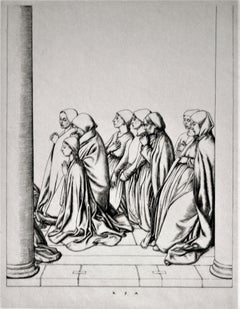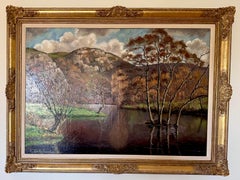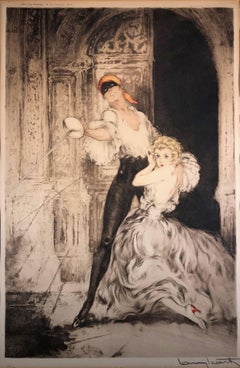Renaissance Art
to
1
2
1
1
1
1
1
Overall Height
to
Overall Width
to
2,260
554
377
208
110
103
95
89
22
16
3
1
1
1
1
1
115
48
106
50
1
2
1
1
78
2
4
46
1
1
1
1
1
1
1
Style: Renaissance
Period: 1930s
Women at Prayer
Located in Storrs, CT
10 15/16 x 8 7/16 (sheet 13 13/16 x 10 13/16). Subsequent to Dodgson. Edition 40 published by the Twenty-One Gallery for 7 guineas. Illustrated: Fine Prints of the Year, 1936. A rich...
Category
1930s Renaissance Art
Materials
Engraving
Inondation à Clécy - Calvados
Located in Los Angeles, CA
PAULÉMILE PISSARRO (1884-1972)
"Inondation à Clécy - Calvados"
Oil on canvas
(31 7/8 x 41 3/4 inches)
Signed.
Painted c. 1935
Paulémile Pissarro, Camille Pissarro’s youngest son, w...
Category
1930s Renaissance Art
Materials
Canvas, Oil
Related Items
Don Juan
By Louis Icart
Located in Missouri, MO
Aquating Engraving
Image Size: approx. 20 1/4 x 13 3/8
Framed Size: 28 x 20.5 inches
Pencil Signed Lower Right
Louis Justin Laurent Icart was born in Toulouse in 1890 and died in Paris in 1950. He lived in New York City in the 1920s, where he became known for his Art-Deco color etchings of glamourous women.
He was first son of Jean and Elisabeth Icart and was officially named Louis Justin Laurent Icart. The use of his initials L.I. would be sufficient in this household. Therefore, from the moment of his birth he was dubbed 'Helli'. The Icart family lived modestly in a small brick home on rue Traversière-de-la-balance, in the culturally rich Southern French city of Toulouse, which was the home of many prominent writers and artists, the most famous being Henri de Toulouse-Lautrec.
Icart entered the l'Ecole Superieure de Commerce de Toulouse in order to continue his studies for a career in business, particularly banking (his father's profession). However, he soon discovered the play writings of Victor Hugo (1802-1885), which were to change the course of his life. Icart borrowed whatever books he could find by Hugo at the Toulouse library, devouring the tales, rich in both romantic imagery and the dilemmas of the human condition. It was through Icart's love of the theater that he developed a taste for all the arts, though the urge to paint was not as yet as strong for him as the urge to act.
It was not until his move to Paris in 1907 that Icart would concentrate on painting, drawing and the production of countless beautiful etchings, which have served (more than the other mediums) to indelibly preserve his name in twentieth century art history.
Art Deco, a term coined at the 1925 Paris Exposition des Arts Decoratifs, had taken its grip on the Paris of the 1920s. By the late 1920s Icart, working for both publications and major fashion and design studios, had become very successful, both artistically and financially. His etchings reached their height of brilliance in this era of Art Deco, and Icart had become the symbol of the epoch. Yet, although Icart has created for us a picture of Paris and New York life in the 1920s and 1930s, he worked in his own style, derived principally from the study of eighteenth-century French masters such as Jean Antoine Watteau, François Boucher and Jean Honoré Fragonard.
In Icart's drawings, one sees the Impressionists Degas...
Category
1920s Renaissance Art
Materials
Engraving, Aquatint
Adele and the Ladies (Rochester's fashion conscious ward in Jane Eyre)
Located in New Orleans, LA
Adele, the 10 year-old girl who may be the daughter of Rochester and Celine in "Jane Eyre" is being scrutinized by three women. One is seated on an ornate sofa...
Category
Early 20th Century Renaissance Art
Materials
Wool, Engraving
Early oil depicting the Great Fire of London
Located in London, GB
The Great Fire of London in September 1666 was one of the greatest disasters in the city’s history. The City, with its wooden houses crowded together in narrow streets, was a natural fire risk, and predictions that London would burn down became a shocking reality. The fire began in a bakery in Pudding Lane, an area near the Thames teeming with warehouses and shops full of flammable materials, such as timber, oil, coal, pitch and turpentine. Inevitably the fire spread rapidly from this area into the City. Our painting depicts the impact of the fire on those who were caught in it and creates a very dramatic impression of what the fire was like. Closer inspection reveals a scene of chaos and panic with people running out of the gates. It shows Cripplegate in the north of the City, with St Giles without Cripplegate to its left, in flames (on the site of the present day Barbican). The painting probably represents the fire on the night of Tuesday 4 September, when four-fifths of the City was burning at once, including St Paul's Cathedral. Old St Paul’s can be seen to the right of the canvas, the medieval church with its thick stone walls, was considered a place of safety, but the building was covered in wooden scaffolding as it was in the midst of being restored by the then little known architect, Christopher Wren and caught fire. Our painting seems to depict a specific moment on the Tuesday night when the lead on St Paul’s caught fire and, as the diarist John Evelyn described: ‘the stones of Paul’s flew like grenades, the melting lead running down the streets in a stream and the very pavements glowing with the firey redness, so as no horse, nor man, was able to tread on them.’
Although the loss of life was minimal, some accounts record only sixteen perished, the magnitude of the property loss was shocking – some four hundred and thirty acres, about eighty per cent of the City proper was destroyed, including over thirteen thousand houses, eighty-nine churches, and fifty-two Guild Halls. Thousands were homeless and financially ruined. The Great Fire, and the subsequent fire of 1676, which destroyed over six hundred houses south of the Thames, changed the appearance of London forever. The one constructive outcome of the Great Fire was that the plague, which had devastated the population of London since 1665, diminished greatly, due to the mass death of the plague-carrying rats in the blaze.
The fire was widely reported in eyewitness accounts, newspapers, letters and diaries. Samuel Pepys recorded climbing the steeple of Barking Church from which he viewed the destroyed City: ‘the saddest sight of desolation that I ever saw.’ There was an official enquiry into the causes of the fire, petitions to the King and Lord Mayor to rebuild, new legislation and building Acts. Naturally, the fire became a dramatic and extremely popular subject for painters and engravers. A group of works relatively closely related to the present picture have been traditionally ascribed to Jan Griffier...
Category
17th Century Renaissance Art
Materials
Oil, Canvas
Altar de St. Antonio de Padua Hand Colored Engraving 1724
Located in Paonia, CO
Anthony of Padua or Anthony of Lisbon born Fernando Martins de Bulhoes 15 August 1195 – 13 June 1231) was a Portuguese Catholic priest and friar of the Franciscan Order. He was born and raised by a wealthy family in Lisbon, Portugal, and died in Padua, Italy. Noted by his contemporaries for his powerful preaching, expert knowledge of scripture, and undying love and devotion to the poor and the sick, he was one of the most quickly canonized saints in church history, being canonized less than a year after his death. He was proclaimed a Doctor of the Church by Pope Pius XII...
Category
1720s Renaissance Art
Materials
Engraving
The Rest on the Flight into Egypt - engraving after Rembrandt - 19th Century
Located in Roma, IT
The Rest on the Flight into Egypt is an engraving on ivory-colored paper realized after Rembrandt by Charles Amand Durand (1831-1905) after an etching by Rembrandt. This wonderful pi...
Category
19th Century Renaissance Art
Materials
Engraving
H 4.34 in W 3.15 in D 0.04 in
Contemporary Oil of Psychic Reading, Tarot Card, and Palm Reading Neon Sign
Located in Fort Worth, TX
Paper, 2020, Daniel Blagg, Oil on canvas, 38 x 58"
By meticulously depicting forgotten road signs and roadside debris, Daniel Blagg invites his viewers to re-consider objects that ...
Category
2010s Renaissance Art
Materials
Canvas, Acrylic, Oil
H 38 in W 58 in D 2.5 in
The Sacristan
By Harry Morley
Located in New Orleans, LA
This image shows a cleric seated in a church sacristy surrounded by religious statues, croziers, various saints, statues and chalices. It is an origina...
Category
Early 20th Century Renaissance Art
Materials
Engraving
'Jesus and the Woman at the Well, ' by Amand-Durand, Engraving
By Armand Durand
Located in Oklahoma City, OK
This early 19th century framed 35" x 31" engraving by artist Amand-Durand depcits an etching of 'Jesus and the Woman at the Well,' after the Dutch master, Rembrandt van Rijn. This poignant Biblical story is depicted by Arman-Durand in Rembrandt style...
Category
Early 19th Century Renaissance Art
Materials
Engraving
H 35 in W 31 in D 2.5 in
A Scene in the New Farce —as performed at the Royalty Theater
Located in Middletown, NY
A Scene in the New Farce —as performed at the Royalty Theater
London: George Humphrey, 1821.
Etching and engraving on cream wove paper with extensive hand coloring in watercolor. 9 5/8 x 13 3/4 inches (244 x 348 mm), trimmed at the platemark. A beautiful impression of this large, intricate print...
Category
Early 19th Century Renaissance Art
Materials
Watercolor, Engraving, Etching
H 9.625 in W 13.75 in
Academie de l’Espee Tabula 2 prints Girarld Thibault Tab. XXXIII & Tab.IIII
Located in Paonia, CO
Two hand colored engravings from the Academie de l’Espee ( full title can be translated as Academy of the Sword: wherein is demonstrated by mathematical rules on the foundation of a mysterious circle the theory and practice of the true and heretofore unknown secrets of handling arms on foot and horseback ) by Girard Thibault...
Category
Early 17th Century Renaissance Art
Materials
Engraving
The Smithy
Located in Middletown, NY
A warm composition, in theme and tone; the creaky timber interior of a 19th century Scottish blacksmith's shop.
Etching and drypoint on cream laid Japan paper, 8 x 10 inches (202 x ...
Category
Late 20th Century Renaissance Art
Materials
Laid Paper, Drypoint, Etching
Contemporary American Nostalgic Sign of MoonLite Drive-In Theatre in West Texas
Located in Fort Worth, TX
Moonlite, 2021, Daniel Blagg, Oil on canvas, 38 x 58"
By meticulously depicting forgotten road signs and roadside debris, Daniel Blagg invites his viewers to re-consider objects th...
Category
2010s Renaissance Art
Materials
Canvas, Acrylic, Oil
Previously Available Items
Inondation à Clécy - Calvados
Located in Los Angeles, CA
PAULÉMILE PISSARRO (1884-1972)
"Inondation à Clécy - Calvados"
Oil on canvas
(31 7/8 x 41 3/4 inches)
Signed.
Painted c. 1935
Paulémile Pissarro, Camille Pissarro’s youngest son, w...
Category
1930s Renaissance Art
Materials
Canvas, Oil
Renaissance art for sale on 1stDibs.
Find a wide variety of authentic Renaissance art available for sale on 1stDibs. Works in this style were very popular during the 21st Century and Contemporary, but contemporary artists have continued to produce works inspired by this movement. Many Pop art paintings were created by popular artists on 1stDibs, including Ian Hornak, Jesus Nodarse, Roni Taharlev, and Theo Toy. Frequently made by artists working with Paper, and Paint and other materials, all of these pieces for sale are unique and have attracted attention over the years. Not every interior allows for large Renaissance art, so small editions measuring 2 inches across are also available. Prices for art made by famous or emerging artists can differ depending on medium, time period and other attributes. On 1stDibs, the price for these items starts at $100 and tops out at $675,000, while the average work sells for $1,450.
Recently Viewed
View AllMore Ways To Browse
Neon Yellow
French Painted Poster
Oil Painting 19th Century Man
Oil Painting Man 19th Century
Old Man Figure
Flower Hat
The Big Five
Distressed Paper
Antique Oil On Canvas In Gilt Frame
Wood Female Figure
Porter Vintage
Drew Gold
Vintage Air Force
Italian Late 19th Century Oil
Twenty Seven
Large 1906
Vintage Mid Century Oil On Canvas Painting
Stone Horse



